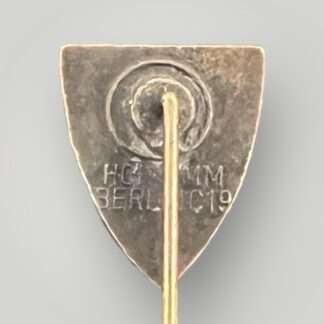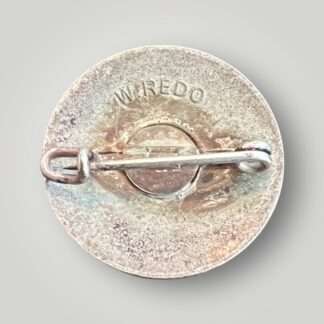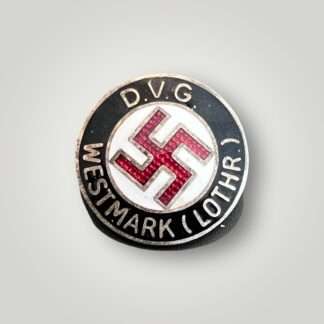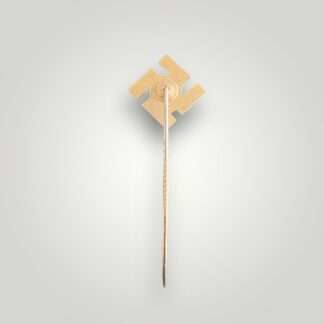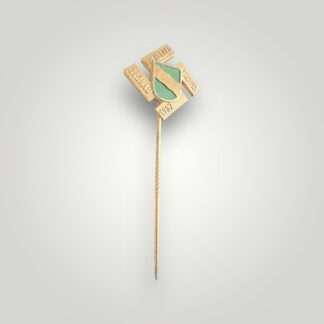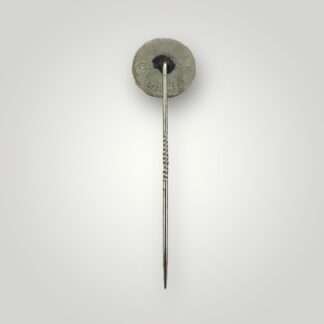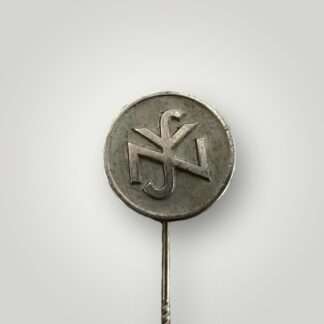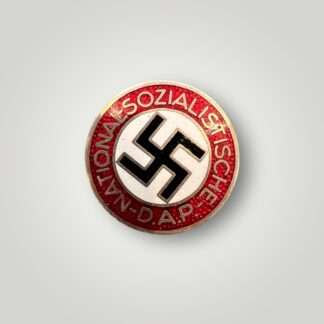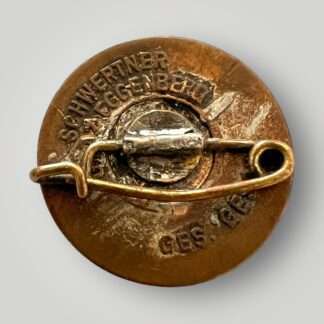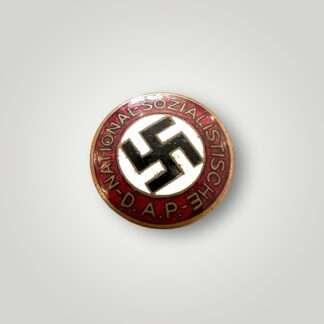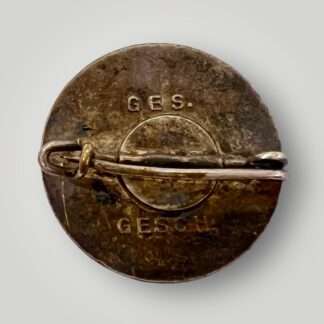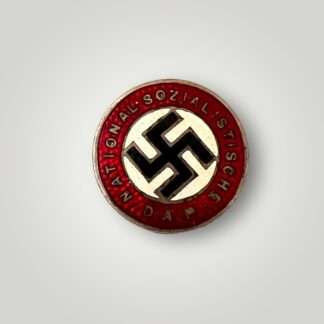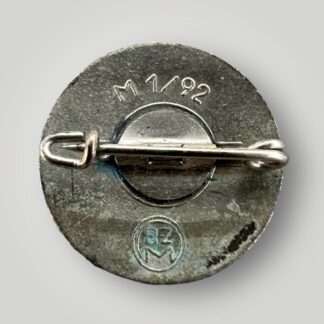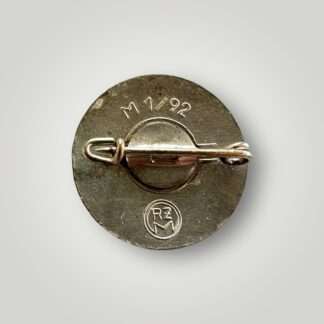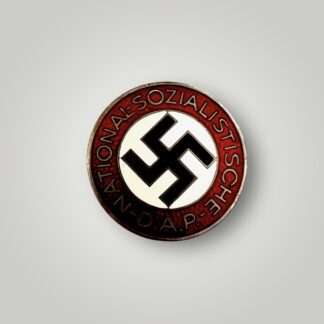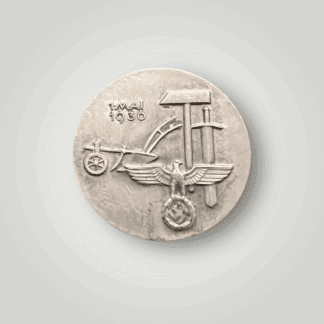Party Day Badges & Pins
In 1933, the introduction of party badges coincided with the NSDAP’s declaration of May 1st as the official state holiday known as the “Day of National Work.” This designation aimed to commemorate laborers and the working classes. Seeking to garner support from the labour force, the Nazis designated May Day, traditionally celebrated by organized labour, as a paid holiday. On May 1, 1933, elaborate celebrations were held to honour German workers, emphasising the importance of acknowledging and appreciating their contributions. Adolf Hitler frequently extolled the virtues of labour, proclaiming in the Völkischer Beobachter that “I only acknowledge one nobility—that of labour.” The regime believed that securing the support of workers was crucial to preventing a recurrence of the 1918 disaster.
Hitler emphasised the need for Germany to honour its workers, portraying them as patriots who played a pivotal role in building the nation’s industrial strength and serving honourably in the war. The regime propagated the idea that the only means to avoid a repeat of past difficulties was to establish a strong bond between workers and the German government. Through extensive propaganda efforts, the regime encouraged all Germans to participate in the May Day celebrations, envisioning that this collective involvement would help dismantle class hostilities between workers and burghers.
State radio broadcasted songs praising labour and workers throughout May Day, accompanied by an air show and fireworks in Berlin. Hitler’s speeches underscored the perceived oppression of workers under economic liberalism and highlighted their crucial role in the nation’s development. Surprisingly, even publications like the Berliner Morgenpost, which had previously been aligned with the political left, praised the regime’s May Day celebrations, reflecting a moment of unity amid diverse political affiliations.
Showing all 55 results
-

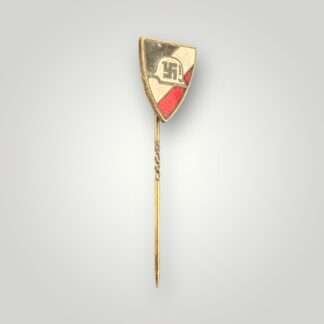
Deutsche Wehr Home Defense League Membership Stick Pin
A scarce Deutsche Wehr Home Defense league membership stick pin, constructed in black, gold, white, and red enamel. The reverse of the stick pin has the makers mark HCH Timm Berlin C19. The badge has no damage or repairs in very good condition.
Product ID: 10610 £125.00View Details Add to Basket -


DVG Westmark (Lothr.) By W.Redo Party Pin
A DVG Westmark (Lothr.) By W.Redo Party Pin (Deutscher Volksgenossen Bund Mitgliedsabzeichen). Constructed in black, red, and white enamel. The obverse of the badge depicts an enameled white disc, overlaid with a canted swastka in red enamel with gold edges. The outer black enamel ring has the inscription in silver “D.V.G. WESTMARK (LOTHR.)". The reverse of the pin has the makers mark “W. REDO”. The party pin has no damage or chips in good condition.
Product ID: 17466 £125.00View Details Add to Basket -
Sold


German NSDAP 1936 Koblenz-Trier Provincial Day Badge
An original German NSDAP 1936 Koblenz-Trier Provincial day badge, constructed in aluminum. The oval shaped day badge depicts the National Eagle clucthing a swastika with a map of Koblenz and Trier embossed "Gau-Tag 26-28.6.36. The rear of the badge has a crimped safety pin assembley, with no damage or repairs in good condition.
Product ID: 17988 £85.00View Details -


German WW2 National Socialist Frauenschaft Enamel Badge
A National Socialist Frauenschaft Enamel Badge (Nationalsozialistische Frauenschaft Mitgliedsabzeichen) constructed in bronze with with multi-coloured enamels. The reverse of the badge is marked with RZM stamp and M1/34 for Karl Wurster, Markneukirchen complete with safety pin assembly. The badge has no damage or repaits in good condition.
Product ID: 18149 £65.00View Details Add to Basket -


Gronau Grenzland Treffen 1937 Stick Pin
An original Gronau Grenzland Treffen 1937 stick pin. This lapel pin commemorates the 1937 meeting that took place in the border district of Gronau, located in North Rhine-Westphalia, Germany. The gathering brought together the districts of Gronau, Grenzland, and Treffen. Featuring the district shield on the front and the national insignia on the back, this non-maker marked pin serves as a memento of that historic event. The badge has no damage or repairs in very good condition.
Product ID: 10601 £50.00View Details Add to Basket -


Hitler Youth Sports Festival Badge 1939 By Redo
An original Hitler youth Sports Festival Badge 1939, constructed aluminium. The badge shows the eagle holding the HJ emblem, at the bottom is dated with the year 1939. The reverse is marked W. Redo, Saarlautern, with horizontal pin assembly. The badge has no damage or repairs.
Product ID: 18150 £20.00View Details Add to Basket -


I. Kreistagung der N.S.D.A.P. Wanne-Eickel Tinnie
A rare I. Kreistagung der N.S.D.A.P. Wanne-Eickel 23-24. Sept. 1933 tinnie , die stamped construction in brass. The badge features an Eagle with open wings, clutching a wreathed swastika with the inscription 'First District Conference of The Nazi Party (NSDAP) Wanne-Eickel, 23-24 September 1933' in the centre is a image of a factory with the Wanne Eickel coat of arms below. The reverse has a horizontal safety pin style catch. The badge has no damage or repairs in good condition.
Product ID: 18086 £60.00View Details Add to Basket -


National Socialist People’s Welfare Organisation (NSV) Pin
A rare National Socialist People's Welfare Organisation (NSV) lapel pin, being a small blackened metal disc with an outer raised white metal border, in the centre of which embossed a white metal symbol of a horizontally elongated N through the centre of which a vertically elongated S, where the S crosses the N a letter V. The reverse of the pin is marked GES. GESCH, with the RZM logo and the number 79 for Walter Amlauf, Leipzig.
Product ID: 10870 £120.00View Details Add to Basket -
Sold


NSDAP Early Enamel Party Badge Marked DRGM
An orginal NSDAP early enamel party badge marked DRGM, constructed in red, white, black, and gold enamel. The reverse of the pin is marked with the patent mark 'DRGM' and the badge is stamped 'Gesh & Gesch’ indicating, Gesetzlich Geschützt, (Protected by Law) complete with horizontl safty pin catch. The NSDAP Party Badge has a few scratch on the enamel otherwise in good condition.
Product ID: 10572 £120.00View Details -
Top


NSDAP Party Badge By Schwertner & Cie, Graz, Eggenberg
An early NSDAP Party Badge By Schwertner & Cie, Graz, Eggenberg, constructed in red, white, black, and gold enamel. The reverse of the pin is stamped "Schwertner & Cie, Graz, Eggenberg" above the pin and “Ges. Gesch.” indicating a legally protected design. The NSDAP Party Badge has no damage or repairs in good condition a rare Austrian variant.
Product ID: 12871 £300.00View Details Add to Basket -
Sold


NSDAP Party Badge Unmarked
An orginal NSDAP party badge unmarked, constructed in red, white, black, and gold enamel. The reverse of the badge has no RZM code, but is marked 'Gesh & Gesch’ indicating, Gesetzlich Geschützt, (Protected by Law) complete with horizontl safty pin catch. The NSDAP party badge has no repairs, and the enamel is free from cracks or chips in good condition.
Product ID: 10415 £165.00View Details -
Sold


NSDAP Party Pin Badge M1/92
An orginal NSDAP Party Pin Badge M1/92, constructed in red, white, black, and gold enamel. The reverse of the pin has the RZM makers mark number 'M1/92' for manufacture Karl Wild of Hamburg, complete with horizontal safety pin-style catch measuring 22.5mm in diametre. The NSDAP Party Badge has no damage or repairs in mint condition.
Product ID: 10936 £165.00View Details -
Sold


NSDAP Party Pin Badge M1/92 – Mint
An orginal NSDAP Party Pin Badge M1/92, constructed in red, white, black, and gold enamel. The reverse of the pin has the RZM makers mark number 'M1/92' for manufacture Karl Wild of Hamburg, complete with horizontal safety pin-style catch measuring 22.5mm in diametre. The NSDAP Party Badge has no damage or repairs in mint condition.
Product ID: 11682 £185.00View Details -
Sold


NSDAP Party Pin Lapel Badge By Steinhauer & Lück ’63’
An early NSDAP party pin lapel badge By Steinhauer & Lück, constructed in white, red, black, and gold enamel. The obverse of the badge depicts a roundal with the inscription 'D.A.P. National-Sozialistische' with a black swastika in the centre with a white background. The reverse of the pin has the RZM logo and number 63 for Steinhauer & Lück, Lüdenscheid. This badge is pre 1935 before the M1 codes were introduced. The NSDAP party pin badge has no damage or repairs in very good condition.
Product ID: 17809 £200.00View Details -


Third Reich 1st May 1936 National Labour Day Badge
This is an original Third Reich 1st May 1936 National Labour Day Badge, manufactured as a solid piece in aluminium. The obverse displays the date '1st May 1936' at the upper left, beneath which are a plough, eagle, and swastika; a large hammer and swords appear to the right. The reverse features a horizontal pin assembly and is maker marked “Paul Schulze & Co, Lübeck.” The badge measures 36 mm in diameter and is preserved in overall extremely fine condition.
Product ID: 18101 £30.00View Details Add to Basket -


Third Reich National Day Of Labour Badge
A Third Reich National Day Of Labour Badge 1934, constructed disc in brass. The obverse of the day badge depicts a man's bust with the inscription above "Tag Der Arbeit" (Day of Labour " with a tack hammer below to the left and a sickle to the right, partially behind the National eagle's outstretched wings, clutching a canted swastika in its talons flanked with the date "1934", below the right of the right-wing is the initials "RK". The reverse has a horizontal pinback with the maker marked “Reichsverband, Pforzheim, 47” on the reverse; measuring 35 mm in diameter; in overall good condition.
Product ID: 18097 £25.00View Details Add to Basket
Showing all 55 results


